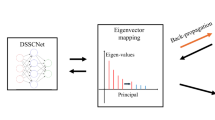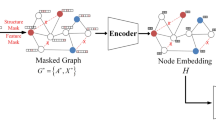Abstract
In this paper, a novel semi-supervised manifold alignment approach via multiple graph embeddings (MA-MGE) is proposed. Different from the traditional manifold alignment algorithms that use a single graph embedding to learn the latent manifold structure of each data set, our approach utilizes multiple graph embeddings to learn a joint latent manifold structure. Therefore a composite manifold representation with complete and more useful information is obtained from each dataset through a dynamic reconstruction of multiple graphs. Also, an optimization strategy based on eigen-value solutions is provided. Experimental results on Protein, COIL-20 and Face-10 datasets demonstrate superior performance of the proposed method compared with the state-of-the-art methods, such as semi-supervised manifold alignment (SSMA), manifold alignment using Procrustes analysis (PAMA) and manifold alignment without correspondence (UNMA).






Similar content being viewed by others
References
Andersson G, Lenz R, Borga M (2013) Modified gradient search for level set based image segmentation. IEEE Trans Image Process 22(2):621–630
Berman HM, Westbrook J, Feng Z, Gilliland G, Bhat TN, Weissig H, Shindyalov IN, Bourne PE (2002) The protein data bank. Genetica 106 (1–2):149–158
Blouvshtein L, Cohen-Or D (2018) Outlier detection for robust multi-dimensional scaling. IEEE Transactions on Pattern Analysis & Machine Intelligence, 1–1
Boucher T, Carey CJ, Mahadevan S, Dyar MD (2015) Aligning mixed manifolds. In: Twenty-ninth Aaai conference on artificial intelligence
Cai D, He X, Zhou K, Han J, Bao H (2007) Locality sensitive discriminant analysis. In: International joint conferences on artificial intelligence (IJCAI), vol 2007, pp 1713–1726
Deerwester S, Dumais S, Harshman R (2010) Indexing by latent semantic analysis. J Assoc Inform Sci Technol 41(6):391–407
Diaz F, Metzler D (2007) Pseudo-aligned multilingual corpora. In: International joint conference on artifical intelligence, pp 2727–2732
Fu S, Liu W, Tao D, Zhou Y, Nie L (2020) Hesgcn: Hessian graph convolutional networks for semi-supervised classification. Inform Sci 514:484–498
Gao Q, Liu J, Cui K, Zhang H, Wang X (2014) Stable locality sensitive discriminant analysis for image recognition. Neural Netw 54(6):49–56
Guerrero R, Ledig C, Rueckert D (2014) Manifold alignment and transfer learning for classification of Alzheimer’s disease. In: Wu G, Zhang D, Zhou L (eds) Machine learning in medical imaging. MLMI 2014. Lecture notes in computer science, vol 8679. Springer, Cham
Gui J, Sun Z, Jia W, Hu R, Lei Y, Ji S (2012) Discriminant sparse neighborhood preserving embedding for face recognition. Pattern Recogn 45 (8):2884–2893
Ham J, Lee D, Saul L (2005) Semisupervised alignment of manifolds. International Workshop on Articial Intelligence & Statistics
Hong D, Yokoya N, Ge N, Chanussot J, Zhu XX (2019) Learnable manifold alignment (lema): a semi-supervised cross-modality learning framework for land cover and land use classification. ISPRS J Photogrammetry Remote Sensing 147:193–205
Houari R, Bounceur A, Kechadi MT, Tari AK, Euler R (2016) Dimensionality reduction in data mining. Expert Syst Appl 64(C):247–260
Huang R, Zhang G, Chen J (2019) Semi-supervised discriminant isomap with application to visualization, image retrieval and classification. Int J Mach Learn Cybern 10(6):1269–1278
Li X, Lv J, Xi W, Xin Y (2017) A semi-supervised manifold alignment algorithm and an evaluation method based on local structure preservation. Neurocomputing 224:195–203
Lu J, Tan YP (2010) Regularized locality preserving projections and its extensions for face recognition. IEEE Trans Syste Man Cybern 40(3):958–963
Malik ZK, Hussain A, Wu J (2016) An online generalized eigenvalue version of Laplacian Eigenmaps for visual big data. Neurocomputing 173:127–136
Narayanan A, Sharmila TS, Gajalakshmi P (2018) Word sign recognition of invariant images based on surf with Laplacian Eigenmaps. In: 2018 International conference on computer, communication, and signal processin (ICCCSP). IEEE, pp 1–4
Nene SA, Nayar SK, Murase H (1996) Columbia object image library (coil-20), Tech. Rep. CUCS-005-96, Department of Computer Science. Columbia University
Nie F, Yuan J, Huang H (2014) Optimal mean robust principal component analysis. In: International conference on machine learning, pp 1062–1070
Nigam K, Ghani R (2000) Analyzing the effectiveness and applicability of co-training. In: International conference on information and knowledge management, pp 86–93
Qiao L, Chen S, Tan X (2010) Sparsity preserving projections with applications to face recognition. Pattern Recogn 43(1):331–341
Socher R, Li FF (2010) Connecting modalities: semi-supervised segmentation and annotation of images using unaligned text corpora. In: Computer vision and pattern recognition, pp 966–973
Tan S, Guan Z, Cai D, Qin X, Bu J, Chen C (2014) Mapping users across networks by manifold alignment on hypergraph. In: AAAI, vol 14, pp 159–165
Vuli I, Moens MF (2014) Probabilistic models of cross-lingual semantic similarity in context based on latent cross-lingual concepts induced from comparable data. In: Conference on empirical methods in natural language processing, pp 349–362
Wang C, Mahadevan S (2008) Manifold alignment using procrustes analysis. In: The 25th international conference on machine learning. ACM, pp 1120–1127
Wang C, Mahadevan S (2009) A general framework for manifold alignment. In: 2009 Association for the advancement of artificial intelligence (AAAI) fall symposium series
Wang C, Mahadevan S (2009) Manifold alignment without correspondence. In: International Joint conference on artifical intelligence, Pasadena, California, USA, July 11-17. Morgan Kaufmann Publishers Inc., pp 1273–1278
Wang C, Mahadevan S (2013) Manifold alignment preserving global geometry. In: 23rd International joint conference on artificial intelligence (IJCAI), pp 1743–1749
Wang L, Zhang H (2019) Nonlinear process monitoring based on improved kpca and extended mvu. Eng Lett, 27(1)
Wang J, Zhang X, Li X, Du J (2017) Semi-supervised manifold alignment with few correspondences. Neurocomputing 230(C):322–331
Wang X, Ren J, Liu S (2018) Distribution adaptation and manifold alignment for complex processes fault diagnosis. Knowl-Based Syst 156:100–112
Yan S, Xu D, Zhang B, Zhang HJ (2005) Graph embedding: a general framework for dimensionality reduction. In: IEEE Computer society conference on computer vision and pattern recognition, 2005, vol 2, pp 830–837
Yang HL, Crawford MM (2013) Learning a joint manifold with global-local preservation for multitemporal hyperspectral image classification. In: 2013 IEEE International geoscience and remote sensing symposium (IGARSS). IEEE, pp 1047–1050
Yang HL, Crawford MM (2015) Spectral and spatial proximity-based manifold alignment for multitemporal hyperspectral image classification. IEEE Trans Geosci Remote Sens 54(1):51–64
Zhang S, Lei YK (2011) Modified locally linear discriminant embedding for plant leaf recognition. Neurocomputing 74(14):2284–2290
Zhang G, Chen J, Su G, Ou C (2016) Comparisons of local methods for face alignment. IET Comput Vis 10(7):728–735
Zhao W, Tan S, Guan Z, Zhang B, Gong M, Cao Z, Wang Q (2018) Learning to map social network users by unified manifold alignment on hypergraph. IEEE Trans Neural Netw Learn Syst 99:1–13
Zhao Y, You X, Yu S, Xu C, Yuan W, Jing X-Y, Zhang T, Tao D (2018) Multi-view manifold learning with locality alignment. Pattern Recogn 78:154–166
Acknowledgements
This work was funded in part by the National Natural Science Foundation of China (No.61572240, 61806086).
Author information
Authors and Affiliations
Corresponding author
Additional information
Publisher’s note
Springer Nature remains neutral with regard to jurisdictional claims in published maps and institutional affiliations.
Rights and permissions
About this article
Cite this article
Huang, CB., Abeo, T.A., Luo, XZ. et al. Semi-supervised manifold alignment with multi-graph embedding. Multimed Tools Appl 79, 20241–20262 (2020). https://doi.org/10.1007/s11042-020-08868-9
Received:
Revised:
Accepted:
Published:
Issue Date:
DOI: https://doi.org/10.1007/s11042-020-08868-9




